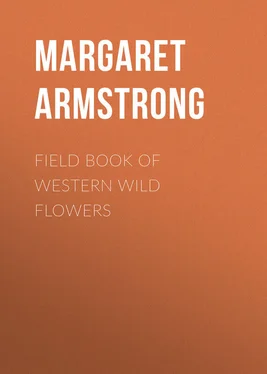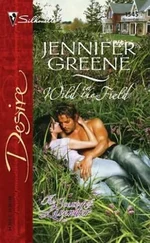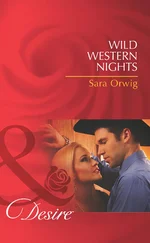Margaret Armstrong - Field Book of Western Wild Flowers
Здесь есть возможность читать онлайн «Margaret Armstrong - Field Book of Western Wild Flowers» — ознакомительный отрывок электронной книги совершенно бесплатно, а после прочтения отрывка купить полную версию. В некоторых случаях можно слушать аудио, скачать через торрент в формате fb2 и присутствует краткое содержание. Жанр: foreign_antique, foreign_prose, на английском языке. Описание произведения, (предисловие) а так же отзывы посетителей доступны на портале библиотеки ЛибКат.
- Название:Field Book of Western Wild Flowers
- Автор:
- Жанр:
- Год:неизвестен
- ISBN:нет данных
- Рейтинг книги:5 / 5. Голосов: 1
-
Избранное:Добавить в избранное
- Отзывы:
-
Ваша оценка:
- 100
- 1
- 2
- 3
- 4
- 5
Field Book of Western Wild Flowers: краткое содержание, описание и аннотация
Предлагаем к чтению аннотацию, описание, краткое содержание или предисловие (зависит от того, что написал сам автор книги «Field Book of Western Wild Flowers»). Если вы не нашли необходимую информацию о книге — напишите в комментариях, мы постараемся отыскать её.
Field Book of Western Wild Flowers — читать онлайн ознакомительный отрывок
Ниже представлен текст книги, разбитый по страницам. Система сохранения места последней прочитанной страницы, позволяет с удобством читать онлайн бесплатно книгу «Field Book of Western Wild Flowers», без необходимости каждый раз заново искать на чём Вы остановились. Поставьте закладку, и сможете в любой момент перейти на страницу, на которой закончили чтение.
Интервал:
Закладка:
Camass – Camassia quamash.
There are six kinds of Clintonia, of North America and Asia; with creeping rootstocks and a few, broad root-leaves; flowers without bracts, their divisions separate, equal or nearly so, each with a stamen at its base; style with two or three, inconspicuous lobes; fruit a berry. These plants were named in honor of De Witt Clinton, Governor of New York, a naturalist, interested in botany, so Thoreau need not have been so annoyed at their having been given this name.
Red Clintonia
Clintònia Andrewsiàna
Red, pink
Spring, summer
Oreg., Cal.
A magnificent plant, one or two feet high, with five or six, exceedingly handsome, glossy, rich green leaves, very conspicuous and sometimes a foot long, and a tall, slightly downy flower-stalk, usually with a few flowers scattered along it, and crowned with a large, roundish cluster of beautiful flowers. They are about three-quarters of an inch long, very rich in color, a deep shade of warm reddish-pink, or crimson, not common in flowers. The form of the cluster varies a good deal; sometimes the flowers are not mostly at the top, but clustered quite thickly along all the upper part of the stalk. The large, deep-blue berries are very handsome and, altogether, this is one of our most conspicuous and attractive woodland plants, especially when growing in the deep shade of redwood forests.
Queen-cup White Clintonia
Clintònia uniflòra
White
Spring
Northwest
In rich moist soil, in shady woods, we find this lovely flower, with a white chalice and heart of pale gold, surrounded by two or three, beautiful, large, glossy leaves, resembling those of Lily-of-the-valley, and fairly carpeting the ground in favorable situations. The slender flower-stalk is hairy, six to ten inches tall, and usually bears a single flower, an inch or more across, with pure-white petals that soon drop off. The fruit is a handsome blue berry.
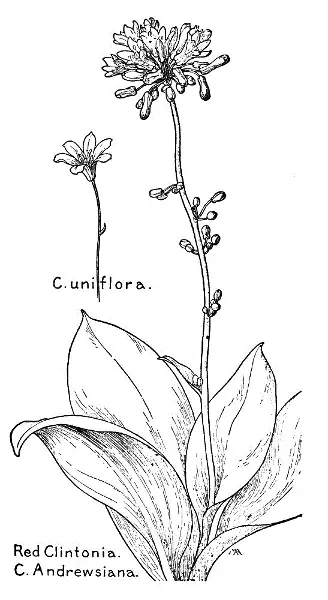
C. uniflora.
Red Clintonia – C. Andrewsiana.
There are a good many kinds of Vagnera, natives of America and Asia, with a single stem, scaly below and leafy above; the leaves alternate, with short leaf-stalks or none; the flowers small, the divisions equal and spreading, white or greenish, in a cluster; the berry round, usually with one or two seeds.
False Solomon's Seal.
Wild Spikenard
Vágnera amplexicàulis(Smilacina)
White
Spring
West
It is a pity that all flowers cannot have really individual names. "False" is especially unattractive and "Solomon's Seal" is confusing, as the flowers are not alike, but this is the old name used all over the world, so it will have to stand, though unworthy of this pleasing plant. It is from one to three feet high, with large, light-green leaves, usually slightly downy on the under side. The flower-cluster is sweet-scented and composed of numerous, very small, cream-white flowers, the conspicuous parts of which are the stamens, white and larger than the petals, giving a feathery appearance to the whole cluster. The fruit is a light-red berry, very finely sprinkled with dark-red dots. This fine tall plant is very decorative and is common in rich moist woods. The name was given in honor of Wagner.
Star-flowered Solomon's Seal
Vágnera sessilifòlia(Smilacina)
White
Spring
West
A gracefully bending plant, from one to two feet high, springing from a slender root-stock. The bright light-green leaves, without leaf-stalks and clasping at base, have a slight "bloom" like some lily leaves and are handsome and conspicuous, but not at all coarse, and are usually very smooth, but sometimes minutely downy. The small, delicate, cream-white flowers, on a very slender, angled flower-stalk, grow in a loose cluster and the berries are reddish-purple or nearly black. This charming plant sometimes forms large patches in moist, rich soil in shady places and its pretty foliage is often very noticeable beside the railroad tracks in Utah.
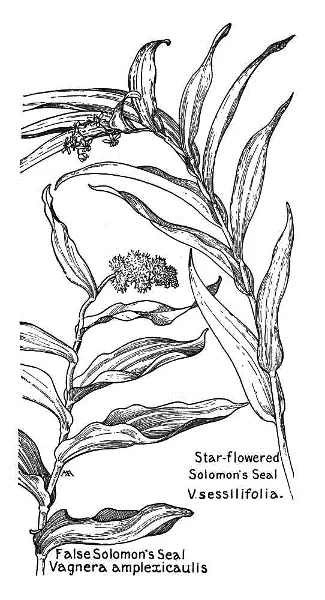
Star-flowered Solomon's Seal – V. sessilifolia.
False Solomon's Seal – Vagnera amplexicaulis.

Fairy Bells are graceful plants, growing in rich, moist, mountain woods, with smoothish, or slightly hairy, branching stems, leafy above and with scaly bracts below, springing from slender root-stocks; leaves netted-veined, alternate, without leaf-stalks, smooth and thin in texture and often clasping the stem; rather small, bell-shaped flowers, hanging from under the leaves, with six stamens and a slender style, with one or three stigmas; the fruit a yellow or red berry. Disporum is from the Greek meaning "double-seed," as in some kinds there are two seeds in each cell of the ovary.
Fairy Bells
Drops of Gold
Dísporum trachycàrpum(Prosartes)
Yellowish-white
Spring, summer
West
A very attractive mountain plant, growing near streams. It is from nine to twenty-four inches tall, with an angled stem, pale green above and reddish below. The delicate flowers, about half an inch long, with a three-lobed green stigma and yellow anthers, grow singly or in clusters of two or three, nodding shyly under the pretty leaves, which are dull above and very shiny on the under side, with oddly crumpled edges and set obliquely on the stem. The berry when unripe is orange color and suggested the name Drops of Gold, but becomes bright red when it matures in June. D. Hookeri is similar, but the style is not three-lobed and the leaves are slightly rough to the touch and are not so thin or crumpled. They spread out so flat that they make a green roof over the flowers, completely screening them from the passer-by. This grows in shady woods, but not near streams.
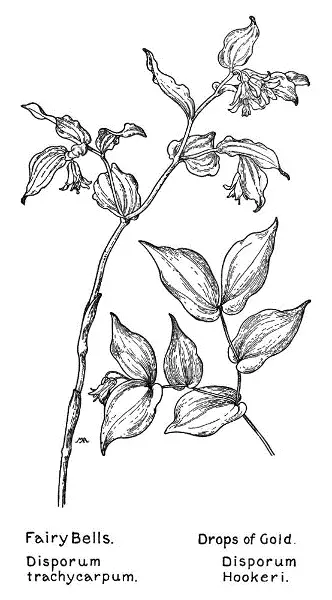
Fairy Bells – Disporum trachycarpum.
Drops of Gold – Disporum Hookeri.
Perhaps the most characteristic western flowers are the members of the genus Calochortus. They grow freely all through the West, as far north as British America, and down into Mexico, but they never get east of Nebraska, so these gay and graceful flowers may be considered the peculiar property of the West. Calochortus means "beautiful grass" and the leaves are usually grasslike, the stems slender and the flowers bright in color, decorative and interesting in form. They have three sepals, often greenish, and three large, colored petals, with a honey-gland, usually covered with hairs, at the base of each. They are allied to true Tulips, so the popular name is suitable, and they fall into three groups: Globe Tulips, with nodding, globular flowers, and nodding capsules; Star Tulips, with erect, star-like flowers and nodding capsules; and Mariposa Tulips, with large, somewhat cup-shaped flowers and erect capsules. Mariposa means "butterfly" in Spanish and is appropriate, for the brilliant hairy spots on the petals are wonderfully like the markings of a butterfly's wing and the airy blossoms seem to have but just alighted on the tips of their slender stalks. They usually grow on dry open hillsides and their leaves have often withered away before the flowers bloom. The various forms run into each other, so that it is impossible to determine all the different species. They have solid bulbs, some of which are edible, considered a delicacy by the Indians and called Noonas.
Читать дальшеИнтервал:
Закладка:
Похожие книги на «Field Book of Western Wild Flowers»
Представляем Вашему вниманию похожие книги на «Field Book of Western Wild Flowers» списком для выбора. Мы отобрали схожую по названию и смыслу литературу в надежде предоставить читателям больше вариантов отыскать новые, интересные, ещё непрочитанные произведения.
Обсуждение, отзывы о книге «Field Book of Western Wild Flowers» и просто собственные мнения читателей. Оставьте ваши комментарии, напишите, что Вы думаете о произведении, его смысле или главных героях. Укажите что конкретно понравилось, а что нет, и почему Вы так считаете.
